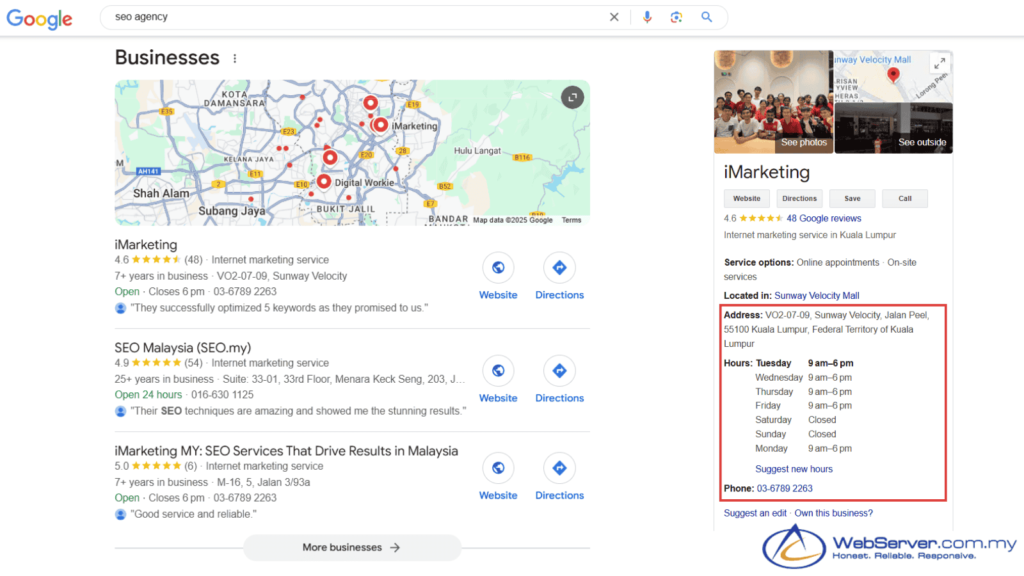-
Sales +603 2770 2833
- sales@webserver.com.my
How to create content for local landing pages for SEO
Table of Contents
Toggle
Content marketing for local SEO is essential for businesses aiming to connect with their local audience and enhance their visibility in local markets. By focusing on a robust local SEO strategy, businesses can create targeted local content that resonates with the community. A well-executed approach to content marketing for local content not only boosts local SEO efforts but also fosters a stronger connection with the local community. Creating local landing pages is essential for businesses looking to attract customers’ attention in specific geographic areas. Local SEO, or Search Engine Optimisation, involves optimising your online presence to attract more business from relevant local searches. A well-optimised local landing page can improve your business’s ranking in local search results, increase traffic, and convert visitors into customers. Here’s a comprehensive guide to creating compelling content for your local landing pages.
Understand Your Local Audience
Knowing your audience is the first step in crafting content that resonates. Start by conducting thorough research to understand your local customers’ demographics, preferences, and needs. Consider age, gender, occupation, interests, and pain points. Here are some ways to gather this information.
- Surveys and Polls: Distribute surveys through email, social media, or directly on your website. Ask questions that help you understand what your customers are looking for, their challenges, and how your product or service can solve their problems.
- Local Search Trends: Use tools like Google Trends to identify what people in your area are searching for. This can give you insights into popular local topics, seasonal trends, and the types of products or services in demand.
- Customer Feedback: Talk to your existing customers. What do they love about your business? What do they wish you offered? Their insights can guide the direction of your content and help you address the needs of potential new customers.
Optimise for Local Keywords
Local keywords are phrases your target audience uses to find businesses like yours. For example, if you run a bakery in Kuala Lumpur, local keywords might include “best bakery in KL,” “KL cupcakes,” or “custom cakes in KL.” Here’s how to effectively optimise your content for local keywords.
- Keyword Research: Use tools like Google Keyword Planner, Ahrefs, or SEMrush to identify relevant local keywords. Look for keywords with a high search volume and low competition. Remember to include long-tail keywords, which are more specific and often have a higher conversion rate (e.g., “gluten-free bakery in KL”).
- Content Integration: Once you’ve identified your keywords, incorporate them naturally. This includes the page title, meta description, headings, and body text. However, avoid keyword stuffing—using the same keywords excessively—as this can hurt your rankings and make your content less readable.
- Local Modifiers: To make your keywords more specific, include city names, neighbourhoods, or landmarks. For example, a “coffee shop near Cheras” could be more effective than a generic “coffee shop in Cheras.”
Include NAP Information

NAP stands for Name, Address, and Phone number. Consistency in NAP information across your website and other online listings is critical for local SEO. Here’s how to make the most of your NAP.
- Prominent Display: Your NAP information should be easy to find. Place it in the header or footer of your landing page to be visible on every page. You can also include it within the content, especially in sections prompting visitors to contact you.
- Consistency Across Platforms: Ensure your NAP information is consistent across all online platforms, including your website, Google My Business, Yelp, and social media profiles. Inconsistent information can confuse search engines and potential customers, negatively affecting your local SEO rankings.
- Google My Business: Make sure your Google My Business listing is up-to-date and has the correct NAP information. This listing is often the first thing people see when they search for local businesses, so accuracy is key.
Use Localised Content
Localised content is content that is specifically tailored to your local audience. This helps with SEO and builds a connection with potential customers by making your business feel more relevant and accessible. Here’s how to create localised content.
- Local Stories and Events: Mention local events, news, or stories relevant to your audience. For instance, if your business sponsors a local event, write about it on your landing page. This shows your involvement in the community and can help you rank for event-related searches.
- Cultural References: Incorporate cultural references that resonate with your local audience. This could be anything from mentioning a local sports team to referencing a popular local hangout. These touches make your content more relatable and engaging.
- Highlight Local Partnerships: If you collaborate with other local businesses, mention these partnerships on your landing page. This can improve your local SEO and show you’re an active community member.
Add High-Quality Images and Videos

Visual content is a powerful tool for making your landing pages more engaging and relatable. Here’s how to effectively use images and videos on your local landing pages.
- Local Imagery: Use images of your business location, team, and area. For example, if you’re a restaurant, include photos of your dishes, dining area, and recognisable local landmarks. This makes your page more visually appealing and signals to visitors that you’re a part of the local community.
- Video Content: Create videos showcasing your business, such as a virtual store tour or testimonials from local customers. Video content is highly engaging and can significantly increase visitors’ time on your page, which is a positive signal to search engines.
- Optimise Visuals: Ensure high-quality images and videos are optimised for fast loading times. Slow-loading pages can drive visitors away, especially on mobile devices commonly used for local searches.
Leverage Customer Reviews and Testimonials
Customer reviews and testimonials are essential for building trust and credibility, especially in local markets where word-of-mouth and community reputation are critical. Here’s how to use them effectively on your regional landing pages.
- Feature Positive Reviews: Highlight positive reviews from local customers on your landing page. This social proof can reassure potential customers that your business is trustworthy and delivers quality services or products.
- Respond to Reviews: Respond to positive and negative reviews to show that you value customer feedback. This demonstrates your commitment to customer satisfaction and can improve your online reputation.
- Use Review Schema Markup: Implementing review schema markup can help search engines display your ratings directly in the search results, making your listing more attractive and likely to be clicked.
Implement Schema Markup
Schema markup is a type of microdata that provides search engines with additional information about your content. This can improve how your page is displayed in search results, potentially leading to higher click-through rates. Here’s how to use schema markup effectively.
- Local Business Schema: Implement local business schema markup to provide detailed information about your business, such as your address, phone number, business hours, and service types. This helps search engines better understand your content and improves your chances of appearing in local search results.
- Review and Rating Schema: If your landing page has customer reviews or ratings, use schema markup to highlight them. This can result in rich snippets that display your ratings in search results, making your listing more attractive.
- Event Schema: If you’re hosting or participating in a local event, use event schema markup to provide details about the event. This can help your event appear in local search results and attract more attendees.
Create Engaging Calls-to-Action (CTAs)
A well-crafted call-to-action (CTA) is essential for guiding visitors toward taking the desired action, whether purchasing, booking a service, or signing up for a newsletter. Here’s how to create effective CTAs for your local landing pages.
- Be Clear and Direct: Your CTA should clearly state what you want the visitor to do, such as “Call Us Today for a Free Estimate” or “Visit Our Store in Kuala Lumpur.” The language should be simple and action-oriented.
- Location-Specific CTAs: Tailor your CTAs to include local references, making them more relevant and persuasive. For instance, “Book Your Table at Our Main Street Location” or “Get Directions to Our South End Office.”
- Use Eye-Catching Design: Your CTA should stand out visually. Use contrasting colours and bold fonts, and strategically place it where it’s easily noticed, such as near the top of the page or after important content sections.
- Create a Sense of Urgency: Encourage immediate action by creating a sense of urgency. Phrases like “Limited Time Offer,” “Book Now,” or “Visit Today” can motivate visitors to take action quickly.
Optimise for Mobile
Mobile optimisation is no longer optional, especially for local searches where many users are on mobile devices. Here’s how to ensure your landing pages are mobile-friendly.
- Responsive Design: Ensure your landing page is responsive, adjusting seamlessly to different screen sizes. This provides a consistent and user-friendly experience, whether visitors are on a smartphone, tablet, or desktop.
- Fast Loading Times: Page speed is critical for mobile users. Optimise images, minimise code and use fast hosting services to ensure your page loads quickly. Slow loading times can lead to high bounce rates, negatively impacting user experience and SEO.
- Easy Navigation: Simplify your navigation for mobile users. Use clear menus and large buttons, and avoid clutter. Ensure important information, like your NAP and CTA, is easily accessible on a mobile screen.
Monitor and Update Your Content
Creating a successful local landing page is an ongoing process. Regularly monitoring and updating your content is essential to maintaining high rankings and ensuring your page remains relevant and engaging. Here’s how to keep your content fresh.
- Use Analytics Tools: Tools like Google Analytics can help you track the performance of your landing page. Monitor traffic, bounce, and conversion rates to understand how visitors interact with your content.
- Update Information Regularly: Ensure your NAP information, business hours, and other critical details are always up-to-date. If you move locations, change your phone number, or update your services, immediately reflect these changes on your landing page.
- Refresh Content: Periodically update your content to keep it relevant. Add new customer testimonials, update images, or tweak your CTAs based on the latest trends and customer feedback. Fresh content can help maintain your SEO rankings and keep visitors engaged.
- Test and Optimise: Continuously test different elements of your landing page, such as headlines, images, and CTAs, to see what resonates best with your audience. A/B testing can help you identify which changes lead to better performance and higher conversion rates.
Bottom Line
Creating local landing pages optimised for SEO is crucial for businesses attracting and converting local customers. To achieve this, it’s important to understand your local audience, optimise for relevant keywords, use localised content, and ensure that your pages are mobile-friendly. Doing so can greatly enhance your local search rankings and more effectively connect with your community.
Engaging with local events and collaborating with local influencers can amplify these efforts, attracting more attention to your offerings. Developing a comprehensive local SEO content strategy allows you to address specific local search queries, ensuring your content meets the needs of your audience.
Remember, local SEO is more than being found – it’s about choosing. The more relevant, engaging, and accessible your landing page is, the more likely you are to convert visitors into loyal customers. Regular updates, consistent monitoring, and a focus on delivering value will help you maintain and grow your local presence in the long term.

WebServer.com.my, a business unit of a privately owned Acme Commerce Sdn Bhd was established in 1989. Specializes in the complex managed hosting services such as database hosting and mission critical application hosting since 1999.
-
Office Hour
+603 2770 2833 -
Extended
+603 2770 2803 -
Email
sales@webserver.com.my -
Technical Support
support@webserver.com.my
Switch The Language




